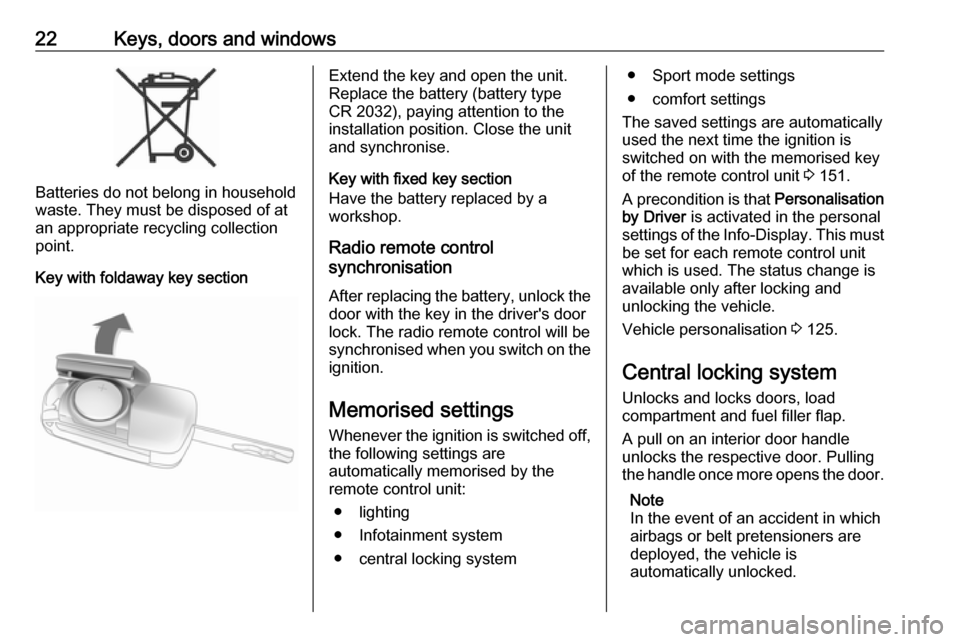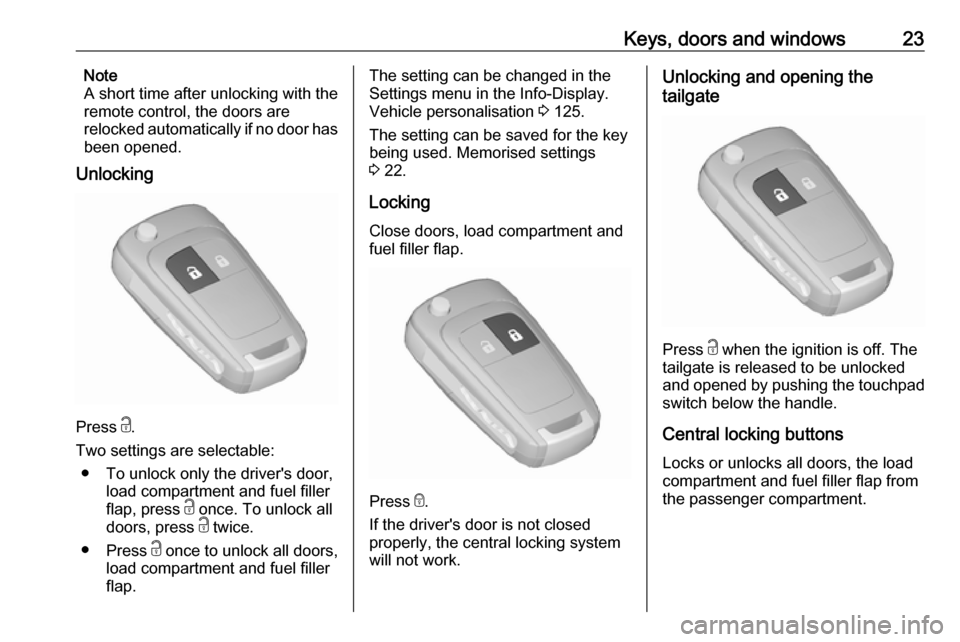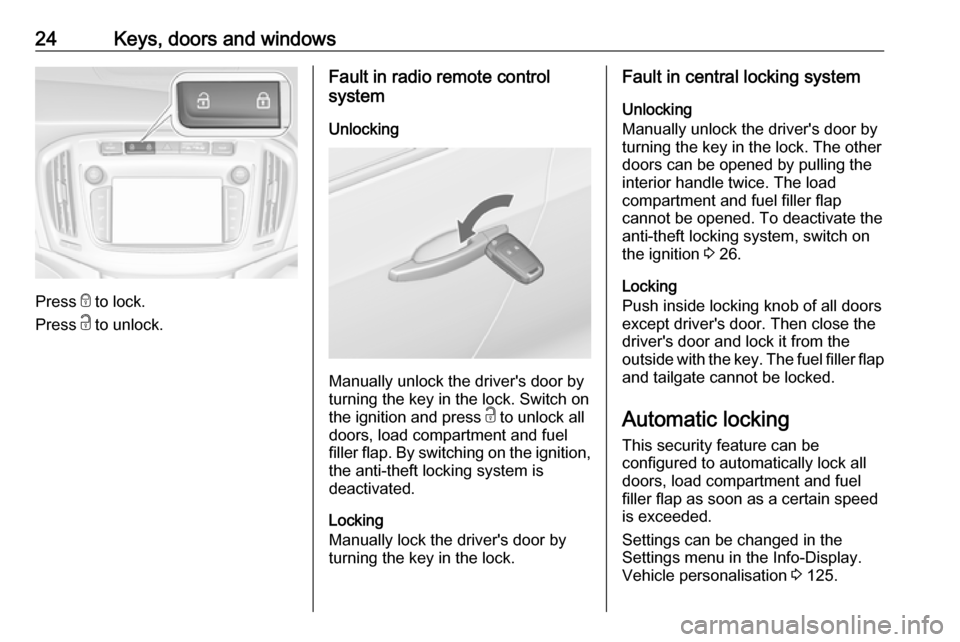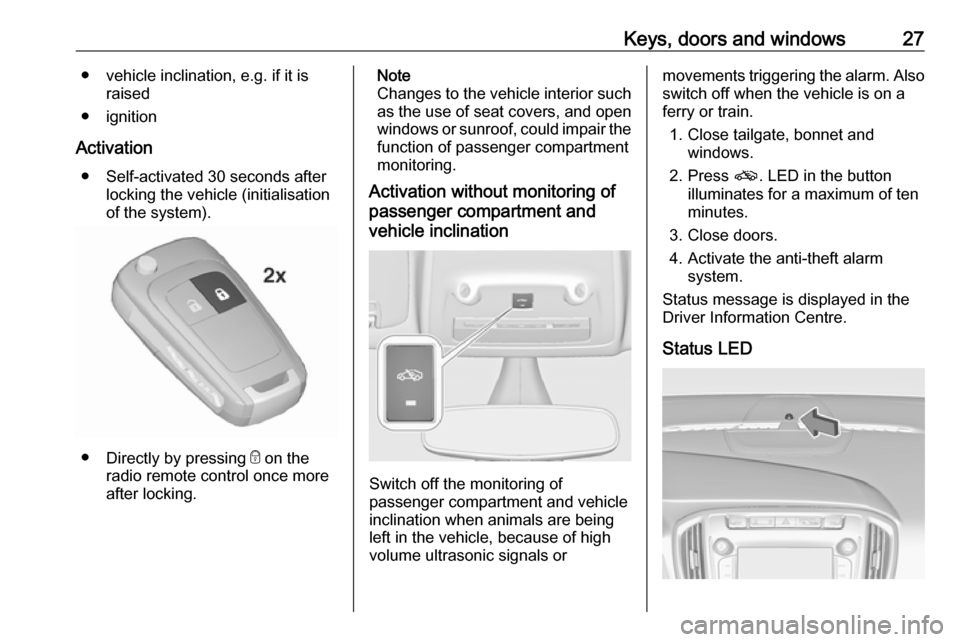ignition OPEL ZAFIRA C 2017.25 Manual user
[x] Cancel search | Manufacturer: OPEL, Model Year: 2017.25, Model line: ZAFIRA C, Model: OPEL ZAFIRA C 2017.25Pages: 291, PDF Size: 9.02 MB
Page 11 of 291

In brief9Exterior mirrors
Select the relevant exterior mirror by
turning the control to the left (L) or
right (R). Adjust respective mirror by
tilting the four-way control.
Convex exterior mirrors 3 29,
Electric adjustment 3 29, Folding
exterior mirrors 3 29, Heated
exterior mirrors 3 30.
Steering wheel adjustment
Unlock the lever, adjust the steering
wheel, then engage the lever and
ensure it is fully locked.
Do not adjust the steering wheel
unless the vehicle is stationary and the steering wheel lock has been
released.
Airbag system 3 54, Ignition
positions 3 151.
Page 13 of 291

In brief111Power windows .....................31
2 Exterior mirrors .....................29
3 Cruise control .....................173
Speed limiter ....................... 174
Adaptive cruise control .......176
Forward collision alert .........182
4 Turn and lane-change
signals, headlight flash,
low beam and high beam,
high beam assist ................137
Exit lighting ......................... 140
Parking lights ...................... 138
Buttons for Driver
Information Centre ..............117
5 Instruments ........................ 104
6 Driver Information Centre .... 117
7 Steering wheel controls .......97
8 Windscreen wiper,
windscreen washer
system, headlight washer
system, rear wiper, rear
washer system ......................98
9 Info-Display ........................ 12110Central locking system ..........22
Hazard warning flashers ....137
Sport mode ........................ 171
Tour mode .......................... 171
Fuel selector ....................... 106
Control indicator for airbag deactivation ........................ 112
11 Anti-theft alarm system
status LED ........................... 26
12 Centre air vents .................. 148
13 Side air vents ...................... 148
14 Glovebox .............................. 66
15 Climate control system ........ 142
16 USB input .............................. 10
Power outlet ........................ 102
17 Selector lever, manual
transmission ....................... 165
Automatic transmission ......162
18 Traction Control system .....169
Electronic Stability Control . 170
Lane departure warning .....197
19 Electric parking brake .........16620Manual parking brake .........166
21 Parking assist systems .......188
Eco button for stop-start
system ................................. 154
22 Ignition switch with
steering wheel lock ............151
23 Horn ..................................... 98
Driver airbag ........................ 57
24 Bonnet release lever ..........215
25 Fuse box ............................ 233
Storage compartment ...........68
26 Light switch ........................ 132
Headlight range
adjustment ......................... 134
Front fog lights ...................137
Rear fog light ...................... 138
Instrument illumination .......139
27 Steering wheel adjustment ..97
Page 19 of 291
![OPEL ZAFIRA C 2017.25 Manual user In brief17Automatic transmissionP:park positionR:reverseN:neutral modeD:automatic modeM:manual mode<:upshift]:downshift
The selector lever can only be movedout of P when the ignition is on and
the br OPEL ZAFIRA C 2017.25 Manual user In brief17Automatic transmissionP:park positionR:reverseN:neutral modeD:automatic modeM:manual mode<:upshift]:downshift
The selector lever can only be movedout of P when the ignition is on and
the br](/img/37/18928/w960_18928-18.png)
In brief17Automatic transmissionP:park positionR:reverseN:neutral modeD:automatic modeM:manual mode<:upshift]:downshift
The selector lever can only be movedout of P when the ignition is on and
the brake pedal is applied. To engage
P or R, press the release button.
Automatic transmission 3 162.
Starting off
Check before starting off ● Tyre pressure and condition 3 237, 3 274.
● Engine oil level and fluid levels 3 216.
● All windows, mirrors, exterior lighting and number plates are
free from dirt, snow and ice and
are operational.
● Proper position of mirrors, seats, and seat belts 3 29, 3 38,
3 51.
● Brake function at low speed, particularly if the brakes are wet.Starting the engine
● Turn key to position 1.
● Move the steering wheel slightly to release the steering wheel
lock.
● Operate clutch and brake pedal. ● Automatic transmission: operate brake pedal and move selector
lever to P or N.
● Do not operate accelerator pedal.
Page 21 of 291

In brief19Parking9Warning
● Do not park the vehicle on an
easily ignitable surface. The
high temperature of the
exhaust system could ignite the
surface.
● Always apply the parking brake. Activate the manual
parking brake without pressing the release button. Apply as
firmly as possible on a downhill slope or uphill slope. Depress
brake pedal at the same time to
reduce operating force.
For vehicles with electric
parking brake, pull switch m for
approx. one second.
The electric parking brake is applied when control indicator
m illuminates 3 112.
● Switch off the engine.
● If the vehicle is on a level surface or uphill slope, engage
first gear or set the selector
lever to position P before
removing the ignition key. On
an uphill slope, turn the front
wheels away from the kerb.
If the vehicle is on a downhill
slope, engage reverse gear or
set the selector lever to position
P before removing the ignition
key. Turn the front wheels
towards the kerb.
● Close the windows.
● Remove the ignition key from the ignition switch. Turn the
steering wheel until the
steering wheel lock is felt to
engage.
For vehicles with automatic
transmission, the key can only
be removed when the selector
lever is in position P.
●
Lock the vehicle by pressing e on
the radio remote control.
● Activate the anti-theft alarm system 3 26.
● The engine cooling fans may run
after the engine has been
switched off 3 215.
Caution
After running at high engine
speeds or with high engine loads,
operate the engine briefly at a low load or run in neutral for
approx. 30 seconds before
switching off, in order to protect
the turbocharger.
Keys, locks 3 20, Laying the vehicle
up for a long period of time 3 214.
Page 22 of 291

20Keys, doors and windowsKeys, doors and
windowsKeys, locks ................................... 20
Keys .......................................... 20
Car Pass .................................... 21
Radio remote control .................21
Memorised settings ...................22
Central locking system ..............22
Automatic locking ......................24
Child locks ................................. 25
Doors ........................................... 25
Load compartment ....................25
Vehicle security ............................ 26
Anti-theft locking system ...........26
Anti-theft alarm system ..............26
Immobiliser ................................ 28
Exterior mirrors ............................ 29
Convex shape ........................... 29
Electric adjustment ....................29
Folding mirrors .......................... 29
Heated mirrors ........................... 30
Interior mirrors ............................. 30
Manual anti-dazzle ....................30
Automatic anti-dazzle ................30Windows...................................... 31
Windscreen ............................... 31
Manual windows ........................31
Power windows ......................... 31
Heated rear window ..................33
Sun visors .................................. 33
Roller blinds ............................... 34
Roof ............................................. 34
Glass panel ............................... 34Keys, locks
KeysCaution
Do not attach heavy or bulky itemsto the ignition key.
Replacement keys
The key number is specified in the
Car Pass or on a detachable tag.
The key number must be quoted
when ordering replacement keys as it
is a component of the immobiliser
system.
Locks 3 254.
The code number of the adapter for
the locking wheel nuts is specified on
a card. It must be quoted when
ordering a replacement adapter.
Wheel changing 3 245.
Page 24 of 291

22Keys, doors and windows
Batteries do not belong in household
waste. They must be disposed of at
an appropriate recycling collection
point.
Key with foldaway key section
Extend the key and open the unit.
Replace the battery (battery type CR 2032), paying attention to the
installation position. Close the unit
and synchronise.
Key with fixed key section
Have the battery replaced by a
workshop.
Radio remote control
synchronisation
After replacing the battery, unlock the
door with the key in the driver's door
lock. The radio remote control will be
synchronised when you switch on the
ignition.
Memorised settings Whenever the ignition is switched off,
the following settings are
automatically memorised by the
remote control unit:
● lighting
● Infotainment system
● central locking system● Sport mode settings
● comfort settings
The saved settings are automatically
used the next time the ignition is
switched on with the memorised key
of the remote control unit 3 151.
A precondition is that Personalisation
by Driver is activated in the personal
settings of the Info-Display. This must
be set for each remote control unit
which is used. The status change is
available only after locking and
unlocking the vehicle.
Vehicle personalisation 3 125.
Central locking system
Unlocks and locks doors, load
compartment and fuel filler flap.
A pull on an interior door handle
unlocks the respective door. Pulling
the handle once more opens the door.
Note
In the event of an accident in which
airbags or belt pretensioners are
deployed, the vehicle is
automatically unlocked.
Page 25 of 291

Keys, doors and windows23Note
A short time after unlocking with the
remote control, the doors are
relocked automatically if no door has
been opened.
Unlocking
Press c.
Two settings are selectable: ● To unlock only the driver's door, load compartment and fuel filler
flap, press c once. To unlock all
doors, press c twice.
● Press c once to unlock all doors,
load compartment and fuel filler
flap.
The setting can be changed in the
Settings menu in the Info-Display.
Vehicle personalisation 3 125.
The setting can be saved for the key
being used. Memorised settings
3 22.
Locking
Close doors, load compartment and
fuel filler flap.
Press e.
If the driver's door is not closed
properly, the central locking system will not work.
Unlocking and opening the
tailgate
Press c when the ignition is off. The
tailgate is released to be unlocked
and opened by pushing the touchpad switch below the handle.
Central locking buttons Locks or unlocks all doors, the load
compartment and fuel filler flap from
the passenger compartment.
Page 26 of 291

24Keys, doors and windows
Press e to lock.
Press c to unlock.
Fault in radio remote control
system
Unlocking
Manually unlock the driver's door by
turning the key in the lock. Switch on
the ignition and press c to unlock all
doors, load compartment and fuel
filler flap. By switching on the ignition, the anti-theft locking system is
deactivated.
Locking
Manually lock the driver's door by
turning the key in the lock.
Fault in central locking system
Unlocking
Manually unlock the driver's door by
turning the key in the lock. The other
doors can be opened by pulling the
interior handle twice. The load
compartment and fuel filler flap
cannot be opened. To deactivate the
anti-theft locking system, switch on
the ignition 3 26.
Locking
Push inside locking knob of all doors
except driver's door. Then close the
driver's door and lock it from the
outside with the key. The fuel filler flap and tailgate cannot be locked.
Automatic locking
This security feature can be
configured to automatically lock all
doors, load compartment and fuel
filler flap as soon as a certain speed
is exceeded.
Settings can be changed in the
Settings menu in the Info-Display.
Vehicle personalisation 3 125.
Page 29 of 291

Keys, doors and windows27● vehicle inclination, e.g. if it israised
● ignition
Activation ● Self-activated 30 seconds after locking the vehicle (initialisation
of the system).
● Directly by pressing e on the
radio remote control once more
after locking.
Note
Changes to the vehicle interior such
as the use of seat covers, and open
windows or sunroof, could impair the
function of passenger compartment
monitoring.
Activation without monitoring of
passenger compartment and
vehicle inclination
Switch off the monitoring of
passenger compartment and vehicle
inclination when animals are being
left in the vehicle, because of high
volume ultrasonic signals or
movements triggering the alarm. Also switch off when the vehicle is on a
ferry or train.
1. Close tailgate, bonnet and windows.
2. Press o. LED in the button
illuminates for a maximum of ten
minutes.
3. Close doors.
4. Activate the anti-theft alarm system.
Status message is displayed in the
Driver Information Centre.
Status LED
Page 30 of 291

28Keys, doors and windowsStatus LED is integrated into the
sensor on top of the instrument panel.
Status during the first 30 seconds of
anti-theft alarm system activation:LED illuminates:test, arming delayLED flashes
quickly:doors, tailgate or
bonnet not
completely closed,
or system fault
Status after system is armed:
LED flashes
slowly:system is armed
Seek the assistance of a workshop in
the event of faults.
Deactivation Unlocking the vehicle deactivates the
anti-theft alarm system.
Alarm When triggered, the alarm horn
sounds and the hazard warning lights flash simultaneously. The number
and duration of alarm signals are
stipulated by legislation.
The alarm can be silenced by
pressing any button on the radio
remote control or by switching on the
ignition.
The anti-theft alarm system can be
deactivated only by pressing c or by
switching on the ignition.
A triggered alarm, which has not been interrupted by the driver, will be
indicated by the hazard warning
lights. They will flash quickly three
times when the vehicle is next
unlocked with the radio remote
control. Additionally, a warning
message is displayed in the Driver
Information Centre after switching on
the ignition.
Vehicle messages 3 123.
If the vehicle's battery is to be
disconnected (e.g. for maintenance
work), the alarm siren must be
deactivated as follows: switch the
ignition on then off, then disconnect
the vehicle's battery within
15 seconds.Immobiliser
The system is part of the ignition
switch and checks whether the
vehicle is allowed to be started with
the key being used.
The immobiliser is activated
automatically after the key has been removed from the ignition switch.
If the control indicator d flashes when
the ignition is on, there is a fault in the system; the engine cannot be started.
Switch off the ignition and repeat the
start attempt.
If the control indicator continues
flashing, attempt to start the engine
using the spare key and seek the
assistance of a workshop.
Note
The immobiliser does not lock the
doors. You should always lock the
vehicle after leaving it and switch on the anti-theft alarm system 3 22,
3 26.
Control indicator d 3 116.